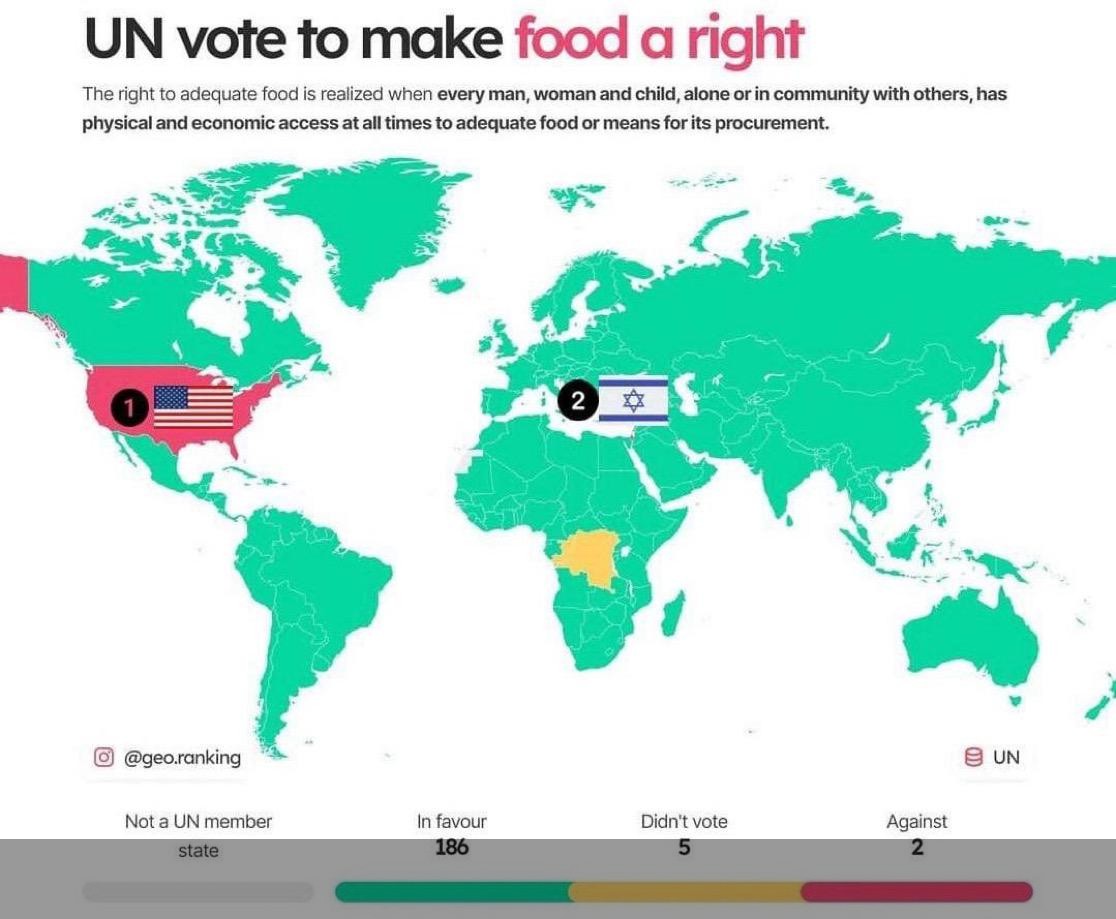Map of 2021 UN General Assembly Vote on Food as Human Right


Marcus Rodriguez
Historical Geography Expert
Marcus Rodriguez specializes in historical cartography and geographic data analysis. With a background in both history and geography, he brings unique...
Geographic Analysis
What This Map Shows
The map visualizes the results of the non-binding vote by the United Nations General Assembly in 2021, which aimed to recognize food as a fundamental human right. Each country is color-coded based on whether they voted in favor, against, or abstained from the resolution. This map serves as a visual representation of global consensus, or lack thereof, regarding the importance of food security and nutrition as a human right. It highlights the geopolitical landscape surrounding food rights and offers insights into which nations prioritize this issue.
Deep Dive into Food as a Human Right
Food is not just a necessity for survival; it's a fundamental human right recognized under international law. The right to food is enshrined in Article 11 of the International Covenant on Economic, Social and Cultural Rights (ICESCR), which states that everyone has the right to an adequate standard of living, including adequate food. However, despite this recognition, millions around the world still suffer from hunger and malnutrition. In fact, according to the Food and Agriculture Organization (FAO), approximately 828 million people were undernourished globally in 2021.
Interestingly, the issue of food security spans beyond mere availability. It encompasses accessibility, utilization, and sustainability of food resources. The 2021 UN vote aimed to reaffirm the commitment of nations to combat food insecurity and malnutrition, which have been exacerbated by conflicts, climate change, and economic instability.
Various factors contribute to food insecurity, including agricultural productivity, economic policies, and social safety nets. For instance, in regions where agricultural practices are heavily reliant on climate-sensitive crops, fluctuations in weather can drastically affect food availability. In many developing countries, poverty and lack of infrastructure further complicate the issue, making it difficult for vulnerable populations to access nutritious food.
Moreover, the COVID-19 pandemic has dramatically shifted the landscape of food security. Supply chain disruptions, economic downturns, and increased unemployment have pushed many into food insecurity. Interestingly, the UN's recognition of food as a human right seeks to address these systemic challenges by encouraging nations to prioritize food security in their policy-making decisions.
Regional Analysis
Examining the map reveals significant regional variations in attitudes towards the right to food. For instance, countries in Western Europe and parts of Latin America predominantly voted in favor of the resolution, reflecting a strong commitment to human rights and social welfare policies. Countries like Germany, France, and Brazil have long-standing programs aimed at combating hunger and promoting sustainable agricultural practices.
Conversely, several nations in the Middle East and parts of Africa voted against or abstained from the vote. For instance, countries facing political instability or ongoing conflict, such as Syria and Yemen, are grappling with severe food insecurity, which undoubtedly influences their stance on such resolutions. Interestingly, these nations often prioritize immediate humanitarian responses over long-term commitments to recognizing food as a human right.
In Asia, the voting patterns were mixed. Countries like India and China showed abstention, possibly reflecting their ongoing struggles with food distribution and poverty within their vast populations. With over 200 million people facing hunger in India alone, the complexities of food rights become even more pronounced.
Significance and Impact
The significance of recognizing food as a human right cannot be overstated. It sets a global standard and places pressure on governments to take meaningful action toward eradicating hunger and malnutrition. By framing food security as a human right, the international community encourages accountability and fosters a legal framework for advocacy.
Moreover, in a world where climate change poses an imminent threat to food systems, the implications of the 2021 vote are timely. Governments are urged to adapt agricultural practices, invest in sustainable technologies, and address the root causes of food insecurity. The recognition of food as a human right also intersects with various other rights, including the right to health, education, and a clean environment.
As we look toward the future, it is crucial for nations to build resilient food systems that can withstand challenges like climate change and global pandemics. Ensuring that food is considered a human right could be the turning point in the global fight against hunger. Ultimately, the map serves as a reminder of both the progress made and the work that lies ahead in achieving food security for all.
Visualization Details
- Published
- August 3, 2025
- Views
- 900
Comments
Loading comments...